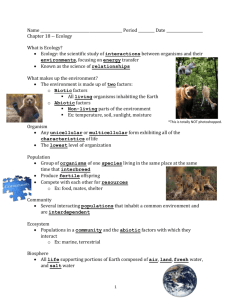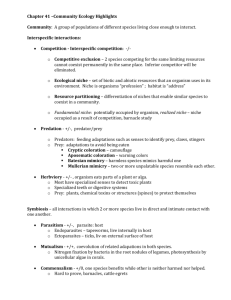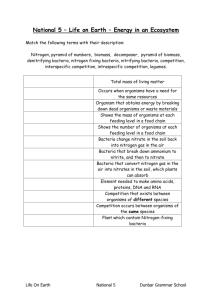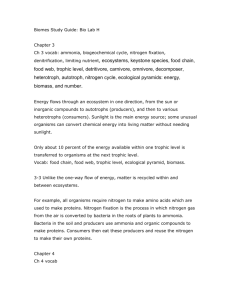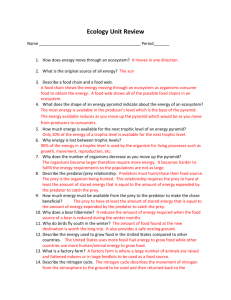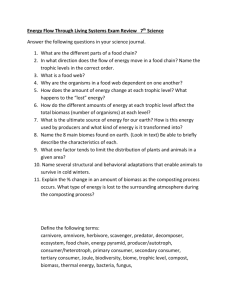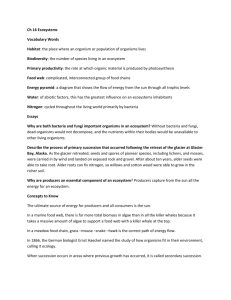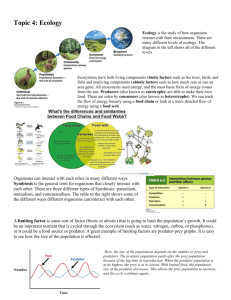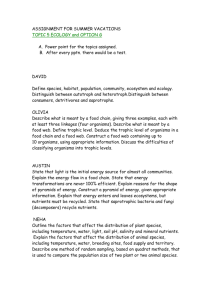Chapter Outline
advertisement
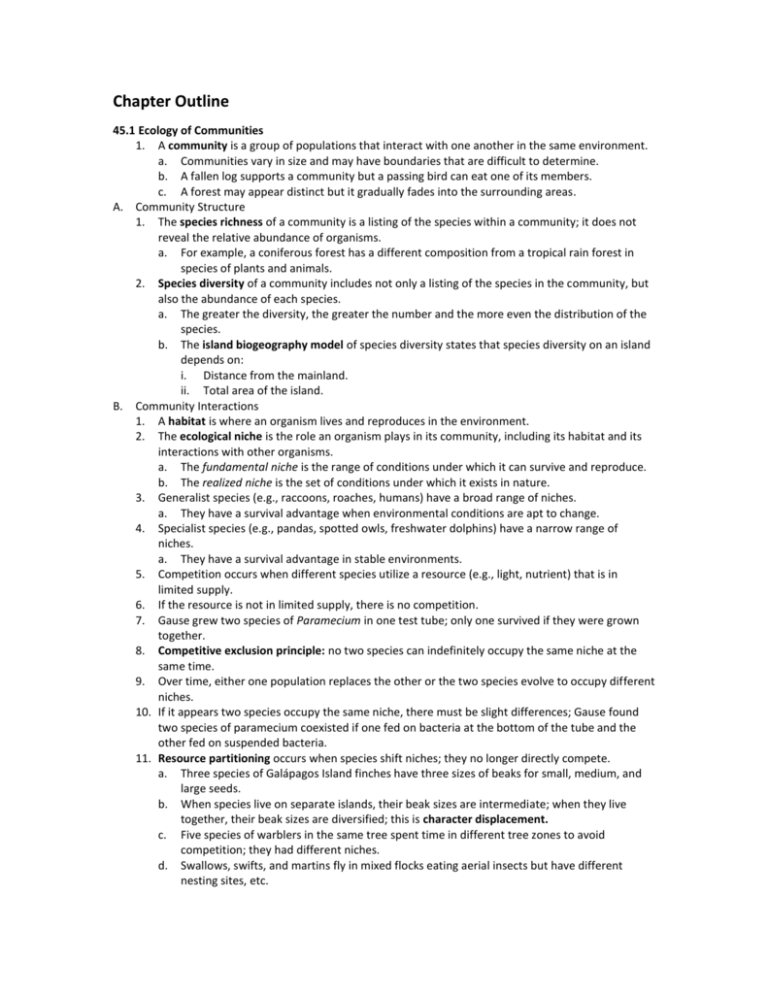
Chapter Outline 45.1 Ecology of Communities 1. A community is a group of populations that interact with one another in the same environment. a. Communities vary in size and may have boundaries that are difficult to determine. b. A fallen log supports a community but a passing bird can eat one of its members. c. A forest may appear distinct but it gradually fades into the surrounding areas. A. Community Structure 1. The species richness of a community is a listing of the species within a community; it does not reveal the relative abundance of organisms. a. For example, a coniferous forest has a different composition from a tropical rain forest in species of plants and animals. 2. Species diversity of a community includes not only a listing of the species in the community, but also the abundance of each species. a. The greater the diversity, the greater the number and the more even the distribution of the species. b. The island biogeography model of species diversity states that species diversity on an island depends on: i. Distance from the mainland. ii. Total area of the island. B. Community Interactions 1. A habitat is where an organism lives and reproduces in the environment. 2. The ecological niche is the role an organism plays in its community, including its habitat and its interactions with other organisms. a. The fundamental niche is the range of conditions under which it can survive and reproduce. b. The realized niche is the set of conditions under which it exists in nature. 3. Generalist species (e.g., raccoons, roaches, humans) have a broad range of niches. a. They have a survival advantage when environmental conditions are apt to change. 4. Specialist species (e.g., pandas, spotted owls, freshwater dolphins) have a narrow range of niches. a. They have a survival advantage in stable environments. 5. Competition occurs when different species utilize a resource (e.g., light, nutrient) that is in limited supply. 6. If the resource is not in limited supply, there is no competition. 7. Gause grew two species of Paramecium in one test tube; only one survived if they were grown together. 8. Competitive exclusion principle: no two species can indefinitely occupy the same niche at the same time. 9. Over time, either one population replaces the other or the two species evolve to occupy different niches. 10. If it appears two species occupy the same niche, there must be slight differences; Gause found two species of paramecium coexisted if one fed on bacteria at the bottom of the tube and the other fed on suspended bacteria. 11. Resource partitioning occurs when species shift niches; they no longer directly compete. a. Three species of Galápagos Island finches have three sizes of beaks for small, medium, and large seeds. b. When species live on separate islands, their beak sizes are intermediate; when they live together, their beak sizes are diversified; this is character displacement. c. Five species of warblers in the same tree spent time in different tree zones to avoid competition; they had different niches. d. Swallows, swifts, and martins fly in mixed flocks eating aerial insects but have different nesting sites, etc. e. f. C. The above examples are deduced from already completed partitioning. Joseph Connell studied the competition occurring in barnacles that consistently shift to match shoreline tidal zones. i. By removing the larger Balanus barnacles from the lower zone, the smaller, Chthamalus, barnacles easily moved in. ii. The smaller barnacle is more resistant to drying out; but the larger one can overgrow it. Predator-Prey Interactions 1. Predation occurs when one organism (predator) feeds on another (prey). 2. In a broad sense, it includes not only single predator-prey kills, but also filter feeding whales that strain krill, parasitic ticks that suck blood, and even herbivorous deer that eat leaves. 3. Parasitism is also considered a type of predation because one organism obtains nutrients from another organism. 4. Predator-Prey Population Dynamics a. Some predators reduce the densities of their prey. i. When Gause reared the protozoans Paramecium caudatum and Didinium nasutum together in culture, Didinium ate all the Paramecium and then died of starvation. ii. When prickly-pear cactus was introduced to Australia from South America, it spread wildly without competition in the desert; a natural predator moth from South America was introduced and the cactus and moth populations plummeted dramatically. b. Natural predator-prey relationships allow persistent populations of both predator and prey populations, though both may fluctuate over time. i. Often a graph of predator-prey population densities shows regular peaks and valleys with the predator population lagging slightly behind the prey; two reasons are possible. a) The biotic potential of the predator may be great enough to overconsume the prey; the prey population declines and the predator population then follows. b) Or the biotic potential of the prey is unable to keep pace and the prey population overshoots the carrying capacity and suffers a crash. 5. The Snowshoe Hare and the Canadian Lynx a. Careful records of pelts of both animals for over a century have demonstrated regular fluctuations. b. To test whether the lynx or hare food supply was causing the cycling, three experiments were done. i. A hare population was given a constant supply of food and predators were excluded; the cycling ceased. ii. The hare populations were given a constant food supply but predators were not excluded; the cycling continued. iii. Predators were then excluded but no extra food was added; the cycling continued. c. The interpretation of these results is that both a hare food cycle and a predator-hare cycle combine to produce the overall effect. d. The grouse population also cycle, perhaps because the lynx switches to grouse when the hare populations decline; thus predators and prey do not normally exist as simple twospecies systems. 6. Prey Defenses a. Prey have evolved a variety of antipredator defenses that include: i. Heightened senses ii. Speed iii. Protective armor, spines, or thorns iv. Tails and appendages that break off v. Chemical defenses b. Camouflage is a form of defense that allows the organism to blend into the background. c. Animals also may have the following defenses: i. Warning coloration ii. Startle response iii. Association with other prey Mimicry a. Mimicry occurs if one species (the mimic) resembles another species (the model) possessing an antipredator defense. b. Batesian mimicry, named for Henry Bates, is a form of mimicry in which one species that lacks defense mimics another that has successful defenses. c. Müllerian mimicry, named for Fritz Müller, is where several different species with the protective defenses mimic one another (e.g., stinging insects all share same black and yellow color bands). D. Symbiotic Relationships 1. Symbiosis is a close relationship between members of two populations. 2. Parasitism a. Parasitism is similar to predation; the parasite derives nourishment from the host. b. Viruses are always parasitic; parasites occur in all kingdoms of life. c. Endoparasites are small and live inside the host. d. Ectoparasites are larger and remain attached to the body of hosts by specialized organs or appendages. e. Many parasites have two hosts. i. The primary host is the main source of nutrition. ii. The secondary host may serve to transport (vector) the parasite to other hosts. f. Parasites are specific, requiring certain species as hosts. 3. Commensalism a. In commensalism, one species benefits and the other is neither harmed nor benefitted. b. It is difficult to determine true commensalism because it is difficult to ensure that the host is not harmed. c. Barnacles secure a home by attaching themselves to the backs of whales and the shells of horseshoe crabs. d. Remora fish attach themselves to the bellies of sharks, securing a free ride and the remains of the shark’s meals. e. Epiphytes (Spanish moss) grow in the branches of trees to receive light but take no nourishment from the tree. f. Clownfish live within the tentacles of sea anemones for protection. g. Some relationships are so loose that it is difficult to know if they are true commensalism. i. Cattle egrets feed near cattle because they flush insects as they graze. ii. Baboons and antelopes forage together for added protection. 4. Mutualism a. In mutualism, both species benefit. b. Mutualism can be found among organisms in all kingdoms of life. c. Examples include the following: i. Bacteria in the human intestinal tract are provided with some of our food but also provide us with vitamins. ii. Termites can only feed on wood because their gut contains the protozoa that digest cellulose. iii. Mycorrhizae are symbiotic associations between the roots of fungal hyphae and plants. iv. Flowers and insect pollinators represent a shift from insects eating pollen to eating nectar, this is an example of coevolution. v. Lichens are made of algae that produce food and fungi that preserve water, although the algae can survive alone. d. Classic Example of the Ant and the Acacia Tree i. In tropical America, the bullhorn acacia provides a home for ants in its hollow thorns. ii. The acacia also provides ants with food from its nectaries, and protein in nodules called Beltian bodies. iii. In return, the ant protects the plant from herbivores and other plants that might shade 7. it. iv. When ants on an experimental tree were killed with insecticide, the tree also died. f. Cleaning Symbiosis i. Crustacea, fish, and birds act as cleaners to a variety of vertebrate clients; this is called cleaning symbiosis. ii. Large fish on coral reefs line up at cleaning stations and wait their turn to be cleaned by small fish. iii. The possibility of feeding on host tissues as well as on ectoparasites complicates this case. E. Island Biogeography Pertains to Biodiversity (Nature of Science reading) 1. Robert MacArthur and E. O. Wilson developed the general theory of island biogeography. 2. Nearby islands have more species because immigration is easier. 3. Larger islands have more species because a large island has more resources. 4. “Islands” can also include patches of forest surrounded by cropland, housing developments, etc. a. The spatial heterogeneity model describes the patchiness of an environment. b. The greater the number of habitat patches, the greater the diversity. 5. An equilibrium point is reached when the rate of species immigration matches the rate of species extinction. 6. An equilibrium point can be dynamic with many species arriving and departing, or steady unless disturbed. 7. Stratification is an increase in vertical living spaces; a tree canopy provides a high-rise habitat and vertical patchiness. F. Interactions and Coevolution (Evolution reading) 1. Coevolution occurs when two species adapt in response to selective pressure imposed by the other. 2. Symbiotic associations are especially prone to the process of coevolution. a. An example of coevolution is between flowers and their pollinators. Flowers pollinated by animals have features that attract them. b. Another example of coevolution occurs between predators and prey. i. Cheetahs sprint forward to catch prey, and gazelles that are fast enough avoid capture. Over generations, a fast running speed may put selective pressure on the predator for an adaptation to the prey’s defense mechanism. c. Coevolution can also take form as the relationship between parasite and host. i. When snails of the genus Succinea are parasitized by worms of the genus Leucochloridium, they are eaten by birds. As worms mature, they invade the snail’s eyestalks, making them resemble edible caterpillars. The birds then eat the snails, and the parasites release their eggs. 45.2 Community Development 1. Communities change over both short and long intervals of time due to continental drift, glaciation, etc. A. Ecological Succession 1. Ecological succession is a change involving a series of species replacements in a community following a disturbance. 2. Primary succession begins in a habitat lacking soil; this might occur following a volcanic eruption. 3. Secondary succession begins when soil is already present but it has been disturbed and returns to a natural state, as in an abandoned cornfield. a. In the first years, wild grasses and other pioneer species (plants that are invaders of disturbed areas) invade. b. Soon sedges and shrubs invade. c. Later, there is a mixture of shrubs and trees. 4. In 1916, Clements proposed the climax-pattern model of succession: that succession leads to a climax community that is characteristic for an area. a. A climax community has a community composition that depends on climate. i. Dry climates eventually produce deserts. ii. Wet climates proceed to forests. iii. Intermediate moisture will result in grasslands, shrubs, etc. iv. Soils will also influence the developing community. b. Each stage facilitates the occurrence of the next stage (called the facilitation model). i. Shrubs cannot grow on dunes until the dune grass has developed the soil. ii. Therefore the grass-shrub-forest must occur sequentially. 5. The inhibition model challenged Clements’s view of succession. a. Colonists hold onto their space and inhibit the growth of other plants until the colonists die. b. Death releases resources that allow different, longer-lived species to invade. 6. The tolerance model provides yet another view of succession. a. Sheer chance may determine which seeds arrive first; in this case, the successional stages may merely reflect the maturation time. b. Trees merely take more time to develop; however, both facilitation and inhibition of growth may be taking place. 7. All models are probably involved and succession may not often reach the same final potential natural community. 45.3 Dynamics of an Ecosystem 1. In an ecosystem, populations interact among themselves and with the physical environment. A. Autotrophs 1. Autotrophs capture energy (e.g., sunlight) and use it, along with inorganic nutrients, to produce organic compounds; therefore they are also called producers. 2. Photosynthetic organisms possess chlorophyll and carry on photosynthesis. a. Algae are the main producers in freshwater and marine environments. b. Green plants are the main land photosynthesizers. 3. Chemoautotrophs are bacteria that obtain energy from the oxidation of inorganic compounds such as ammonia, nitrites, and sulfides; they synthesize carbohydrates and are found in cave communities and ocean depths. B. Heterotrophs 1. Heterotrophs need a source of preformed organic nutrients and consume tissues of other organisms; they are called consumers. 2. Herbivores are animals that feed directly on green plants (or algae). 3. Carnivores are animals that eat other animals. 4. Omnivores can feed upon a variety of organisms, including plants and animals; humans are omnivores. 5. Decomposers are nonphotosynthetic bacteria and fungi that extract energy from dead matter, including animal wastes in the soil, and make nutrients available. 6. Some animals (e.g., earthworms) feed on detritus, the decomposing products of organisms— these organisms are called detritivores. C. Energy Flow 1. All ecosystems are dependent upon solar energy flow and finite pools of nutrients. 2. Most ecosystems cannot exist without a continual supply of solar energy. 3. Energy flow in an ecosystem is a consequence of two fundamental laws of thermodynamics. a. The first law of thermodynamics states energy can neither be created nor destroyed; it can only be changed from one form of energy to another. b. The second law of thermodynamics states when energy is transformed from one form to another, there is always some loss of energy from the system, usually as low grade heat. 4. An Example of Energy Flow a. The complex trophic (feeding) relationships that exist in nature are called food webs. b. A grazing food web begins with leaves, stems, and seeds eaten by herbivores and omnivores. c. A detrital food web begins with detritus, followed by decomposers (including bacteria and fungi). d. Detrital food chains are connected to a grazing food chain when consumers of a grazing food chain feed on the decomposers of the detrital food chain. In some ecosystems, more energy may move through the detrital food web than moves through the grazing food web. f. A food chain represents a single path sequence of organisms that form links. 5. A trophic level is a feeding level of one or more populations in a food web; those organisms in an ecosystem that are the same number of food chain steps from the energy input into the system: a. First trophic level—primary producers. b. Second trophic level—all the primary consumers. c. Third trophic level—all the secondary consumers, etc. 6. About 10% of the energy at a particular trophic level is incorporated into the next trophic level. a. Thus, 1,000 kg (or kcal in an energy pyramid) of plant material converts to 100 kg of herbivore tissue, which converts to 10 kg of first carnivores, which can support 1 kg of second level carnivores. b. This rapid loss of energy is the reason food chains have from three to four links, rarely five. c. This rapid loss of energy is also the reason there are few large carnivores. 7. An ecological pyramid shows this trophic structure of an ecosystem as a graph representing biomass, organism number, or energy content of each trophic level in a food web. 8. The base of the pyramid represents the producer trophic level, and from there the consumer trophic level is stacked, with the apex representing the highest consumer trophic level. 9. A pyramid of numbers is based on the number of organisms in each trophic level. 10. A pyramid of biomass is based on the weight (biomass) of organisms at each trophic level at one time; this eliminates size of the organisms as a factor. a. Usually a large mass of plants supports a medium mass of herbivores and a small mass of carnivores. b. However, at one point in time at seashores, herbivores can have greater biomass feeding on algae that reproduce fast but are eaten, producing an inverted pyramid; over long time periods, the biomass is a normal pyramid. 11. One problem is where to fit in the decomposers; a large portion of energy becomes detritus in many ecosystems. D. Chemical Cycling 1. Biogeochemical cycles are the pathways by which chemicals circulate through the biotic and abiotic components of an ecosystem. 2. Some cycles are primarily gaseous cycles (carbon and nitrogen); others are sedimentary cycles, (phosphorus). 3. A reservoir is that portion of Earth that acts as a storehouse for the element. 4. An exchange pool is the portion of the environment from which producers take chemicals, such as the atmosphere or soil. 5. The biotic community is the pathway through which chemicals move through food chains. 6. The Water Cycle a. A transfer rate is defined as the amount of a substance that moves from one component of the environment to another within a specified period of time. b. In the water or hydrologic cycle, freshwater evaporates and condenses on Earth. c. The evaporation of water from the oceans leaves behind salts; during condensation, a gas is exchanged into a liquid—vaporized fresh water rises into the atmosphere and returns to Earth in the form of precipitation. d. Precipitation that percolates into the Earth forms a groundwater table, or simply, water table. e. An aquifer is an underground storage of fresh water in porous rock trapped by impervious rock. f. Freshwater makes up about 3% of the world’s supply of water and is considered a renewable resource. g. However, freshwater becomes unavailable when consumption exceeds supply or is so polluted that it is not usable; when water withdrawal from aquifers exceeds replenishment, e. 7. 8. 9. it is called “groundwater mining.” The Carbon Cycle a. Both terrestrial and aquatic organisms exchange carbon dioxide with the atmosphere—this is called the carbon cycle. b. On land, photosynthesis removes CO 2 from the atmosphere; respiration then returns CO2 to the atmosphere. c. CO2 from the air combines with water to produce bicarbonate (HCO3-), which is a source of carbon for aquatic producers, primarily protists. d. Similarly, when aquatic organisms respire, the CO 2 they release combines with water to form bicarbonate ions (HCO3-). e. The reservoir for the carbon cycle is largely composed of organic matter, calcium carbonate in shells, and limestone, as well as fossil fuels. f. The transfer rates between photosynthesis and respiration (including decay) are about even. g. Because we burn fossil fuels and forests, there is now more CO2 entering the atmosphere than is removed. h. CO2, nitrous oxide, and methane are greenhouse gases that contribute to the rise in Earth’s temperature, a phenomenon called global warming. i. The above gases and water vapor increase the greenhouse effect that holds heat next to the Earth. j. Climate change is a term that refers to the recent changes in the Earth’s climate. i. Since the Industrial Revolution, the global climate has increased 0.6°C. k. The increased heat may cause more clouds that in turn increase global warming. l. Computer models cannot incorporate all variables; predictions are for 1.5–4.5oC increase by 2100. m. Results include glaciers melting, sea level rising, a redistribution of dry and wet regions, and an increase in species extinctions. The Phosphorus Cycle a. In the phosphorus cycle, weathering makes phosphate ions (PO3- and HPO4+) available to plants that take up phosphate from the soil. b. Some of this phosphate runs off into aquatic ecosystems where algae incorporate it into organic molecules before it is entrapped in sediments. c. Phosphate that is not taken up by algae is incorporated into sediments in the oceans. d. Sediment phosphate only becomes available when geological upheaval exposes sedimentary rocks. e. Phosphate taken up by producers is incorporated into a variety of organic compounds. f. Animals eat producers and incorporate some of the phosphate into phospholipids, ATP, and nucleotides of DNA; however what is in teeth, bones, and shells does not decay for long periods. g. Decay of organisms and decomposition of animal wastes eventually makes phosphate ions available again. h. Available phosphate is generally taken up quickly; it is usually the limiting nutrient in most ecosystems. i. Humans boost the supply of phosphate by mining phosphate ores for fertilizers, detergents, etc. j. Run-off of animal wastes from livestock feedlots and commercial fertilizers from cropland as well as discharge of untreated and treated municipal sewage can all add excess phosphate to nearby waters. k. Eutrophication is the name of this over-enrichment that leads to algal blooms; when the algae die off, decomposers use up all of the oxygen and this can cause a massive fish kill. The Nitrogen Cycle a. Nitrogen gas (N2) is 78% of the atmosphere, yet nitrogen deficiency can limit plant growth. b. In the nitrogen cycle, plants cannot incorporate N 2 into organic compounds and they therefore depend on the various types of bacteria to make nitrogen available to them. c. E. Nitrogen fixation occurs when N2 is converted to a form that plants can use. i. Other nitrogen-fixing bacteria, living in nodules on the roots of legumes, make reduced nitrogen and organic compounds available to a host plant. ii. Some cyanobacteria in water and the free-living bacteria in soil are able to reduce N2 to ammonium (NH4+ ). iii. Plants take up both NH4+ and nitrate (NO3-) from the soil. iv. After plants take up NO3-, it is enzymatically reduced to NH4+ that is then used to synthesize amino and nucleic acids. d. Nitrification is the production of nitrates (NO3-). i. Nitrogen gas is converted to NO3- in the atmosphere when cosmic radiation, meteor trails, and lightning provide the high energy for nitrogen to react with oxygen. ii. Nitrifying bacteria convert NH4+ to NO3-. iii. Ammonium in the soil is converted to NO3- by nitrifying bacteria in the soil in a two-step process that does not depend on nitrogen gas. a) First, nitrite-producing bacteria convert NH4+ to nitrite (NO2-). b) Then, nitrate-producing bacteria convert NO2- to NO3-. e. Denitrification is conversion of NO3- to nitrous oxide (N2O) and N2. i. There are denitrifying bacteria in both aquatic and terrestrial ecosystems. ii. Denitrification counterbalances nitrogen fixation, but not completely; more nitrogen fixation occurs. f. Human Activities and the Nitrogen Cycle i. Production of fertilizers and burning of fossil fuels adds three times the nitrogen oxides to the atmosphere as normal. ii. Acid deposition occurs when nitrogen oxides and sulfur oxides combine with water vapor in the atmosphere. Global Climate Change (Nature of Science reading) 1. The average temperature in the U.S. has risen since 1901 a. The warmest decade on record was 2000-2009. 2. With the increase in temperature, there have also been increases in drought conditions in some areas, and increased precipitation in other areas, as well as increased sea level. 3. U.S. produced greenhouse gas emissions have increased by 14 percent from 1990-2008. 4. Since global climate change affects the entire world population, global cooperation is required in order to solve the problems at hand. 5. The Kyoto Protocol, which has been enforced since 2005, has the goal to achieve stabilization and reduction of greenhouse gas concentrations. a. The United States has not ratified the agreement. 6. The Copenhagen conference in 2009 did not create any binding agreement for long term action against climate change. a. One of the outcomes of this conference was the commitment to raise money to help poor countries cope with the effects of climate change. 7. The Cancun summit in 2010 solidified the agreement to raise funds to help poor countries defend against climate change.
